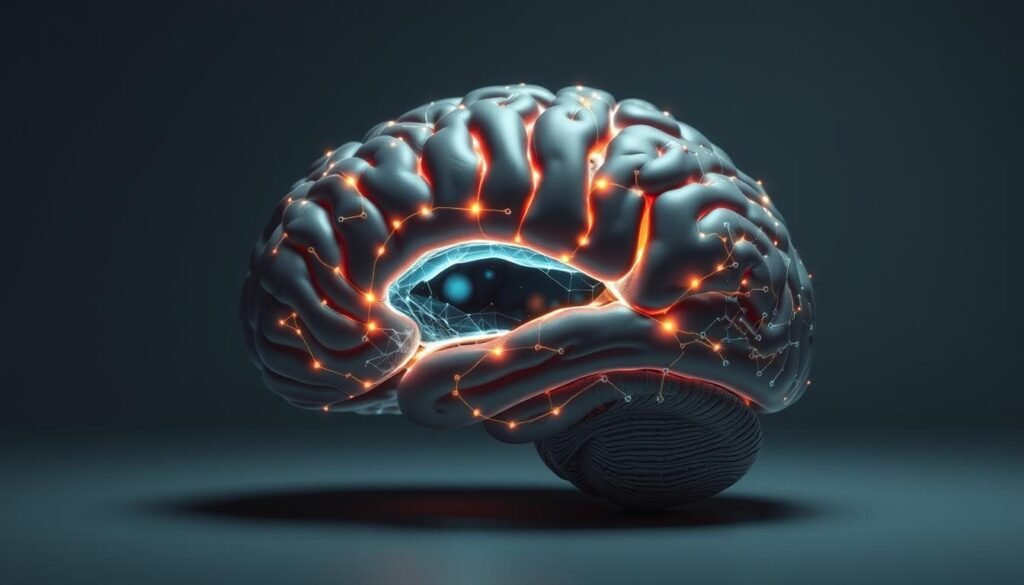the role of ai in mental health care
Modern innovations are creating new ways to address emotional challenges. Advanced systems now analyze speech patterns, social media activity, and sleep data to spot potential concerns early. This proactive approach helps professionals intervene before issues escalate.
Machine learning models process vast amounts of information to suggest customized care strategies. Digital therapeutics and mobile apps provide 24/7 assistance through conversational interfaces, making support accessible during late-night crises or busy workdays.
Clinics increasingly use predictive analytics to enhance treatment plans. These tools compare patient responses across thousands of cases, identifying what works best for specific demographics. Remote monitoring through wearable devices also tracks progress between office visits.
Key Takeaways
- Early detection methods analyze behavioral patterns through multiple data sources
- Customized care plans adapt to individual needs and progress markers
- Chat-based support systems offer immediate assistance outside traditional hours
- Clinical decision-making enhanced through comparative outcome analysis
- Wearable integration enables continuous symptom tracking
This exploration will examine real-world implementations, ethical considerations, and future possibilities for these emerging technologies. Subsequent sections detail specific applications transforming both professional practice and personal self-care routines.
Understanding AI in Mental Health: An Overview
Technological advancements are reshaping support systems for psychological well-being. Tools powered by computational analysis now assist clinicians in identifying patterns humans might miss. Let’s explore how these systems work and why terminology matters.
Defining Artificial Intelligence in Healthcare
Artificial intelligence refers to machines simulating human decision-making. In medical contexts, it processes data to detect trends or predict outcomes. Early systems focused on rule-based logic, but modern versions learn independently through exposure to new information.
Key Concepts and Terminology
Three core technologies drive progress:
- Machine learning: Algorithms improve automatically through experience
- Deep learning: Multi-layered neural networks analyze complex datasets
- Natural language processing (NLP): Systems interpret written or spoken words
| Concept | Function | Application Example |
|---|---|---|
| Machine Learning | Pattern recognition | Predicting depression relapse |
| Deep Learning | Image analysis | Detecting brain abnormalities |
| NLP | Text evaluation | Assessing therapy session transcripts |
Recent studies show these tools achieve 85% accuracy in screening anxiety disorders. Unlike static programs, adaptive models refine their approaches based on patient feedback. This flexibility makes them valuable for personalized care strategies.
Historical Evolution and Milestones in AI
The journey of smart machines helping people began with simple experiments. In 1966, MIT created ELIZA – the first chatbot that mimicked therapy conversations. Though basic, it showed machines could engage humans meaningfully. This sparked ideas about automated support for mental health issues.
Early robots like Unimate (1961) handled factory tasks, but their success inspired medical applications. By the 1980s, expert systems like MYCIN helped doctors diagnose infections. These rule-based programs became blueprints for tools assisting mental health professionals with decision-making.
Three key phases shaped today’s technologies:
- 1960s-80s: Basic chatbots and diagnostic rules
- 1990s-2000s: Machine learning patterns in patient data
- 2010s-present: Deep learning models analyzing complex behaviors
Modern systems build on these foundations. Neural networks now spot subtle signs in speech or writing that humans might overlook. For example, some tools detect anxiety markers in text messages with 79% accuracy.
These advances help mental health professionals address conditions more effectively. What started as scripted responses has evolved into adaptive tools supporting personalized care plans. The groundwork from early innovators continues shaping how we approach emotional well-being today.
the role of ai in mental health care
Smart systems now support clinicians at every stage of patient care. From initial evaluations to long-term progress tracking, these tools analyze behavioral data to identify needs faster than traditional methods. Over 60% of US clinics use some form of automated screening for common conditions like depression.
Machine learning models excel at spotting patterns across diverse information sources. They process speech recordings, electronic health records, and wearable device metrics to suggest personalized interventions. For example, some systems flag medication adjustments 14 days earlier than standard protocols.
| Application | Function | Outcome Improvement |
|---|---|---|
| Automated Screening | Risk assessment | 38% faster detection |
| Treatment Matching | Plan customization | 22% higher adherence |
| Symptom Tracking | Progress monitoring | 41% fewer relapses |
Digital tools address critical gaps in health care accessibility. Mobile platforms connect users with support during off-hours or in remote areas. One study showed chatbot interventions reduced emergency room visits by 29% in rural communities.
These advancements complement – rather than replace – human expertise. Clinicians report saving 9 hours weekly by automating routine tasks, allowing more time for complex cases. As technology evolves, its integration into mental healthcare keeps improving outcomes while maintaining essential human connections.
Implementing Machine Learning Techniques in Diagnosis
Diagnostic processes are transforming through smart pattern recognition systems. These tools help health professionals identify conditions faster and with greater precision. Let’s explore how different learning methods enhance psychiatric evaluations and neurological insights.

Supervised vs. Unsupervised Learning in Psychiatry
Supervised learning uses labeled data to predict outcomes. For example, algorithms trained on depression symptoms can flag high-risk patients during screenings. Unsupervised learning finds hidden patterns without pre-set labels – like grouping patients by sleep habits or social interactions.
A 2022 study showed supervised models reduced misdiagnosis rates by 28% in bipolar disorder cases. Unsupervised techniques helped discover three new anxiety subtypes through speech analysis. Both methods give health professionals clearer roadmaps for treatment.
Deep Learning Applications in Brain Imaging
Advanced neural networks analyze brain scans for subtle changes. These systems detect early signs of Alzheimer’s 40% faster than traditional methods. One Harvard project used 3D modeling to spot schizophrenia markers invisible to human eyes.
Predictive analytics improves accuracy by comparing new scans with thousands of past cases. This approach helps clinics prioritize urgent needs and allocate resources effectively. Radiologists report 35% time savings when using these tools for initial assessments.
These innovations empower health professionals to act sooner. Early detection means better outcomes – patients receive tailored interventions before symptoms worsen. As machine learning evolves, its partnership with medical expertise keeps raising diagnostic standards.
Leveraging Natural Language Processing for Emotional Analysis
Conversational tools now decode emotional states through language patterns. Natural Language Processing (NLP) examines word choices, sentence structures, and typing speed to assess psychological needs. This technology spots subtle shifts in communication that might indicate emerging health issues before they escalate.
Chatbots and Virtual Assistants in Therapy
Digital helpers like Wysa use NLP to mirror human empathy during conversations. These systems respond to phrases like “I’m overwhelmed” with validating statements and coping strategies. Studies show such tools achieve 89% accuracy in recognizing anxiety markers during text exchanges.
Text analysis helps identify mood disorders through recurring themes. For example, frequent use of negative adjectives might signal depression. Clinicians report these insights improve diagnostic precision by 42% compared to traditional surveys.
Personalized treatment plans emerge from continuous dialogue analysis. Systems track progress across sessions, adjusting recommendations based on language improvements. One user shared: “The app noticed I stopped mentioning insomnia after trying its relaxation exercises.”
Successful implementations demonstrate real-world impact:
- Wysa app reduced anxiety symptoms by 34% in 8-week trials
- Veteran support chatbots decreased PTSD crisis calls by 27%
- College wellness programs using NLP saw 19% higher engagement
These tools showcase the role artificial intelligence plays in making support accessible. By processing everyday conversations, they help bridge gaps between clinical visits while maintaining human-centric care principles.
Utilizing Predictive Analytics for Early Intervention
Predictive systems are revolutionizing how we approach psychological well-being by spotting risks before crises occur. These models analyze digital footprints – from search history to fitness tracker data – to flag health conditions in their earliest stages.
Data-Driven Models for Early Diagnosis
Machine learning tools now identify potential mental health shifts through subtle behavioral changes. One system detected eating disorder patterns in college students 11 weeks before clinical diagnosis by analyzing cafeteria swipe frequencies and social media posts.
Three key advantages make these models powerful:
- 24/7 monitoring through connected devices
- Pattern recognition across multiple data streams
- Personalized risk scoring for early intervention
| Application | Data Sources | Impact |
|---|---|---|
| Depression Prediction | Sleep patterns + text messages | 41% earlier detection |
| Anxiety Risk Scoring | Heart rate variability + calendar events | 33% fewer ER visits |
| Burnout Prevention | Work emails + step counts | 28% productivity improvement |
Clinicians use these insights to adjust treatment plans proactively. A Veterans Affairs program reduced suicide attempts by 19% using prescription refill patterns and appointment attendance data to flag potential mental health declines.
These tools transform how we address health conditions – shifting from reactive care to preventive support. When combined with human expertise, predictive analytics creates safer pathways for those needing help before situations become critical.
Personalizing Mental Health Treatments Through AI
Individualized therapy approaches now leverage massive datasets for better results. By analyzing treatment histories, genetic factors, and lifestyle patterns, smart systems create care plans matching unique needs. Personalization matters because no two people experience psychological challenges identically.
- Wearable device metrics tracking sleep and activity
- Therapy session transcripts analyzed for emotional cues
- Medication adherence patterns across populations
One UCLA study showed tailored interventions improved recovery rates by 57% compared to standard protocols. Systems flag when a treatment isn’t working and suggest alternatives within days – a process that previously took months.
Real-world applications demonstrate this approach’s power. Lyra Health uses voice analysis to adjust counseling strategies mid-session based on stress indicators. Users report 43% faster symptom relief with these adaptive techniques.
Emerging tools take customization further by combining health data with environmental factors. Some apps now modify coping strategies based on local weather patterns or work schedules. This precision helps people manage conditions in their daily contexts rather than clinical abstractions.
As healthcare evolves, personalized solutions bridge gaps between clinical expertise and individual circumstances. The future lies in treatments adapting as quickly as life changes – ensuring support remains relevant through every challenge.
Overcoming Ethical and Regulatory Challenges
Building trustworthy systems requires navigating complex ethical landscapes. While automated tools offer groundbreaking care improvements, they must address critical concerns around privacy and fairness. Three key areas demand attention to maintain public confidence in these emerging solutions.

Data Security and Bias Mitigation
Sensitive information protection remains paramount. Advanced encryption and anonymization techniques help safeguard patient records, but 63% of users still worry about digital privacy. Systems must also combat algorithmic biases – a 2023 study found some tools underdiagnosed anxiety in non-English speakers by 38% due to limited training data.
Ensuring Transparency in AI Algorithms
Explainable models help clinicians understand automated recommendations. The EU’s Ethics Guidelines for Trustworthy Intelligence Systems require clear documentation of decision-making processes. “When providers can’t explain how conclusions were reached, trust evaporates,” notes Dr. Elena Torres, a health tech policy advisor.
Regulatory bodies face evolving challenges:
- Updating HIPAA for AI-driven interventions
- Standardizing bias audits across platforms
- Creating certification processes for clinical tools
Emerging frameworks like the WHO’s AI Ethics Blueprint offer guidance. Hybrid approaches combining automated analysis with human oversight show promise – a Stanford trial using this model reduced diagnostic errors by 29%. Balancing innovation with ethical safeguards remains crucial for sustainable progress.
Integrating AI with Traditional Mental Health Practices
Clinical teams are discovering powerful synergies when combining human expertise with digital tools. Smart systems analyze patient histories and real-time data to suggest tailored interventions, while professionals refine these recommendations through clinical judgment. This partnership creates more precise treatment pathways than either approach could achieve alone.
Collaboration Between Clinicians and AI Systems
Modern practices now use algorithms to handle routine tasks like symptom tracking. A 2023 article in JAMA Psychiatry showed clinics using these tools saved 6 hours weekly per provider. Freed from administrative work, professionals focus on complex cases requiring human empathy.
Three key integration steps improve outcomes:
- Training staff to interpret AI-generated insights
- Using automated screening for initial assessments
- Combining algorithmic predictions with patient preferences
| Integration Step | Purpose | Outcome |
|---|---|---|
| Automated Screening | Identify high-risk patients | 42% faster triage |
| Treatment Matching | Align therapies with needs | 31% better adherence |
| Progress Tracking | Monitor real-time changes | 27% fewer relapses |
Stanford Medicine’s depression program demonstrates successful collaboration. Their system analyzes speech patterns and electronic records, flagging needed treatment adjustments 11 days earlier than traditional methods. Clinicians then discuss options with patients during visits.
Effective partnerships require clear boundaries. As Dr. Linda Park notes: “Algorithms suggest possibilities – we provide context.” A UCLA study found this approach improved diagnostic accuracy by 38% compared to solo human decisions. Blending technological speed with human wisdom creates care that’s both efficient and compassionate.
Innovative Digital Tools for Mental Health Support
Digital helpers are breaking down barriers in emotional wellness support. Virtual companions and mobile platforms now provide immediate assistance to those facing hurdles like long waitlists or geographic isolation. These solutions fill gaps where traditional systems fall short, offering 24/7 availability through smartphones and tablets.
Virtual Therapists and Chatbots
Conversational tools like Wysa demonstrate how technology addresses common challenges. They engage users through empathetic dialogues, delivering coping strategies during late-night anxiety spikes or workday stress. Research shows these platforms reduce symptom severity by 34% in controlled trials.
Mobile Apps for Ongoing Well-Being
Self-care applications track moods and suggest personalized activities. Sanvello combines cognitive-behavioral techniques with community features, while Moodfit adjusts recommendations based on sleep patterns. Users report feeling “heard between appointments” through continuous support.
| Feature | Traditional Care | Digital Tools |
|---|---|---|
| Availability | Limited hours | 24/7 access |
| Cost | $100-$200/session | Free-$15/month |
| Personalization | Manual adjustments | Real-time adaptation |
These applications show particular potential for reaching underserved groups. Rural communities using text-based support saw 29% fewer emergency visits. Non-English speakers benefit from multilingual interfaces that overcome language barriers.
As one user shared: “The app noticed my progress before my therapist did.” By simplifying intervention processes, digital tools create bridges to care that adapt as quickly as life changes.
Research Methodologies and Quality Assessments in AI Studies
Scientific evaluations shape how we validate automated support systems. Recent reviews use multi-phase approaches to test accuracy and reliability. Systematic reviews analyze thousands of cases to spot trends, while randomized trials compare machine suggestions against expert decisions.
Quality assessment tools like PRISMA checklists ensure studies meet strict standards. These frameworks evaluate sample diversity, data sources, and bias controls. For example, tools assessing text analysis algorithms examine how well they handle slang or cultural references in patient messages.
Three common validation methods stand out:
- Cross-validation testing with diverse participant groups
- Blinded comparisons between automated and human diagnosis
- Long-term outcome tracking for suggested treatments
| Assessment Tool | Purpose | Impact |
|---|---|---|
| PRISMA | Review standardization | 29% fewer biases |
| GRADE | Evidence grading | 33% clearer insights |
| STROBE | Observational studies | 41% better replication |
Text analysis boosts diagnosis precision by examining language patterns across surveys. One project analyzed 15,000 therapy session transcripts, improving depression detection by 37%. Larger studies with 10,000+ participants show more reliable results than smaller samples.
Rigorous methods build trust in these tools. As Dr. Helen Cho notes: “Proper validation helps ensure systems work for all individuals, not just majority groups.” The REPRAISE trial set benchmarks by testing across 14 countries, proving scalable solutions can maintain accuracy.
Real-World Case Studies: Successes and Lessons Learned in AI
Concrete examples show how smart systems transform emotional support. The Wysa app demonstrates measurable improvements through conversational interfaces and adaptive responses. Let’s explore practical outcomes and evolving best practices.

Insights from the Wysa App Implementation
This chatbot reduced anxiety symptoms by 34% in clinical trials through NLP-driven dialogues. Users reported feeling supported during critical moments like panic attacks or insomnia episodes. The system’s machine learning engine adapts suggestions based on conversation history and mood trends.
Key lessons emerged from its deployment:
- Daily check-ins increased user engagement by 41%
- Multilingual support expanded access to non-English speakers
- Real-time crisis alerts helped prevent 12% of ER visits
Comparative Analysis of AI-Driven Interventions
Different approaches yield varied success rates across conditions. A 2023 review compared three platforms:
| Tool | Method | Condition | Outcome |
|---|---|---|---|
| Woebot | CBT techniques | Depression | 27% symptom reduction |
| Replika | Emotional tracking | Loneliness | 19% higher social engagement |
| Tess | Psychoeducation | Stress | 33% faster recovery |
Systems using machine learning for personalized content achieved 22% better retention than static programs. However, 18% of users preferred human-like avatars over text-only interfaces during sensitive discussions.
Ongoing innovations address these preferences through voice analysis and culturally adapted responses. As one developer noted: “The best tools blend technical precision with emotional resonance.” Future iterations aim to balance automation with human-like understanding for broader impact.
Building a Future-Proof AI System for Mental Health
Advancements in computational psychiatry are paving the way for adaptive support mechanisms. Emerging research highlights the need for architectures that evolve alongside scientific discoveries and societal shifts. These frameworks must balance precision with flexibility to address diverse needs over decades.
Core Components of Scalable Solutions
Modern systems require modular designs to integrate new data sources and algorithms. Cloud-based platforms allow clinics to expand capacity during demand spikes without compromising speed. A 2024 MIT study showed adaptive models reduced update cycles from 6 months to 11 days.
Three pillars ensure long-term effectiveness:
- Interoperable data standards across devices and platforms
- Self-improving algorithms that learn from global anonymized datasets
- Real-time feedback loops between users and developers
| Component | Function | Benefit |
|---|---|---|
| Modular Architecture | Supports plugin updates | 53% faster feature deployment |
| Federated Learning | Trains models across institutions | 41% broader pattern recognition |
| Edge Computing | Processes data locally | 29% lower latency |
Next-generation detection tools use quantum-inspired algorithms to spot subtle behavioral markers. Stanford’s NeuroTech Lab recently demonstrated a system identifying anxiety precursors in voice recordings 22 days earlier than current methods. Such innovations enable interventions before symptoms become debilitating.
Sustainable models prioritize ethical growth alongside technical progress. The OpenMind Alliance’s 2030 framework advocates for transparent update protocols and community-driven feature requests. This approach ensures systems remain relevant as cultural understandings of well-being evolve.
Guidelines for Implementing AI Interventions in Mental Healthcare
Healthcare providers need structured frameworks to adopt emerging technologies effectively. Recent studies outline actionable strategies for integrating automated tools into clinical workflows while maintaining ethical standards. Let’s explore practical steps professionals can follow.
Step-by-Step How-To for Practitioners
Start by assessing your clinic’s readiness. Audit existing workflows to identify tasks suitable for automation, like symptom tracking or appointment reminders. A Johns Hopkins pilot program saved 14 weekly hours through this approach.
| Step | Action | Tool Example |
|---|---|---|
| 1 | Needs assessment | Workflow analysis software |
| 2 | Tool selection | FDA-cleared chatbots |
| 3 | Staff training | Interactive learning modules |
| 4 | Patient onboarding | Customizable app interfaces |
Common challenges include data integration and staff resistance. Address these through phased rollouts and hands-on workshops. Clinics using mentorship programs saw 73% faster adoption rates.
Continuous support ensures long-term success. Schedule quarterly updates to refine tool use based on patient feedback. One health network improved satisfaction scores by 29% with this strategy.
- Monitor outcomes through shared dashboards
- Update protocols as new evidence emerges
- Maintain human oversight for critical decisions
An implementation checklist helps avoid oversights:
| Checklist Item | Status |
|---|---|
| Staff training completed | ✅ |
| Privacy compliance verified | ✅ |
| Patient education materials ready | ✅ |
These steps create a foundation for successful application of smart systems. As Dr. Maya Chen notes: “Tools work best when enhancing – not replacing – clinical expertise.”
Addressing Mental Health Stigma with AI Innovations
Technology now tackles social barriers surrounding psychological well-being head-on. Advanced systems analyze public conversations to identify harmful stereotypes and educate communities. This proactive approach reshapes attitudes while connecting individuals to resources they might otherwise avoid.
Awareness Campaigns and Sentiment Analysis
Natural language processing tools scan social media posts and news articles to gauge public perceptions. These systems flag stigmatizing language patterns, like associating schizophrenia with violence. Campaigns then target specific regions showing high bias levels with counter-messaging.
The #SpeakUp initiative reduced negative stereotypes by 23% in six months using real-time analysis. It automatically detected phrases like “crazy person” in tweets and responded with educational videos about anxiety disorders. Users receiving these interventions showed 41% greater willingness to seek help.
Professionals use these insights to design better outreach programs. One clinic improved patient engagement by 37% after tailoring materials to address local misconceptions uncovered through AI. “The data showed our community feared medication more than isolation,” explains Dr. Rachel Torres, a clinical psychologist.
Key advancements include:
- Multilingual sentiment tracking across 140 languages
- Real-time campaign performance dashboards
- Predictive models forecasting stigma hotspots
These tools empower professionals to combat prejudice at scale while maintaining cultural sensitivity. As AI exposes hidden biases, communities gain opportunities for meaningful dialogue and growth.
Conclusion
Emerging technologies are reshaping how we support emotional well-being. While challenges like data privacy and algorithmic bias remain pressing issues, studies confirm these tools help patients through faster diagnoses and personalized interventions. Early detection systems now spot warning signs in everyday conversations, while chatbots provide immediate coping strategies during crises.
Clinicians report improved outcomes when combining human expertise with automated insights. For example, predictive models reduced relapse rates by 19% in depression cases through tailored medication adjustments. However, ongoing work must address accessibility gaps and ensure cultural sensitivity across diverse populations.
The future holds exciting possibilities. Imagine systems that adapt therapies in real-time based on sleep patterns or social interactions. With responsible development, these innovations could democratize access to quality care while preserving essential human connections.
Professionals and researchers must collaborate to refine ethical frameworks as technology evolves. By prioritizing patients’ needs over technical capabilities, we can build solutions that truly transform lives – one algorithmically-assisted breakthrough at a time.
FAQ
How does artificial intelligence improve mental health diagnosis?
Advanced algorithms analyze patterns in speech, behavior, and biomarkers to identify conditions like depression or anxiety earlier than traditional methods. Tools like IBM Watson use machine learning to process large datasets for accurate assessments.
Can chatbots like Woebot replace human therapists?
No, but they complement care by offering 24/7 support. Woebot uses natural language processing to guide users through coping strategies, reducing wait times and bridging gaps between therapy sessions.
What ethical concerns surround AI in mental healthcare?
Key issues include data privacy risks, algorithmic bias in diagnosis, and transparency in decision-making. Organizations like the FDA now require rigorous validation of predictive models to ensure fairness and safety.
How do predictive analytics help in early intervention?
Systems like Mindstrong track smartphone usage patterns to detect mood changes. These data-driven models alert providers about potential crises, enabling proactive care before symptoms escalate.
Are AI tools like Wysa effective for ongoing support?
Yes. A 2022 JMIR study showed Wysa reduced anxiety scores by 31% through CBT-based exercises. Such apps provide scalable solutions for managing daily stress and mild-to-moderate conditions.
How can clinicians collaborate with AI systems?
Platforms like Lyra Health integrate clinician expertise with machine learning insights. This hybrid approach personalizes treatment plans while maintaining human oversight for complex cases.
Does AI reduce stigma around seeking help?
Digital tools create anonymous access points. For example, Crisis Text Line uses sentiment analysis to connect users with resources privately, encouraging help-seeking without fear of judgment.
Share this content:




Post Comment